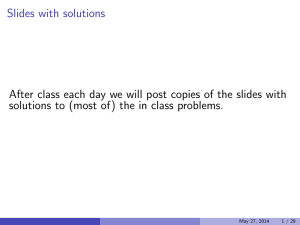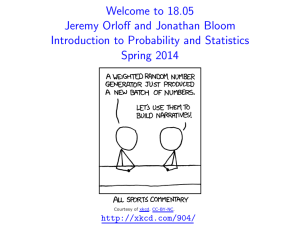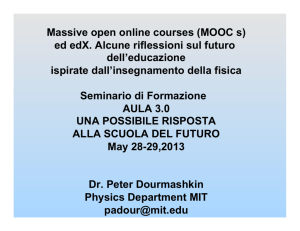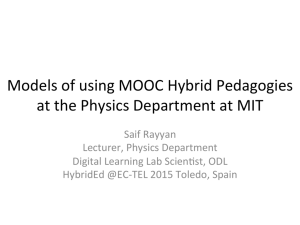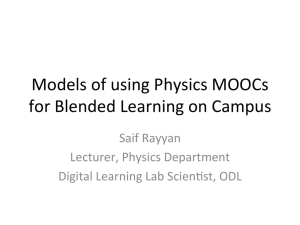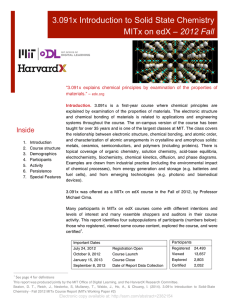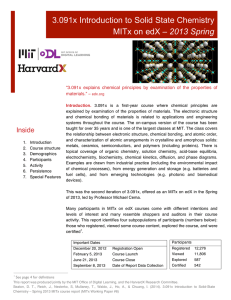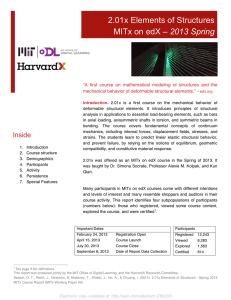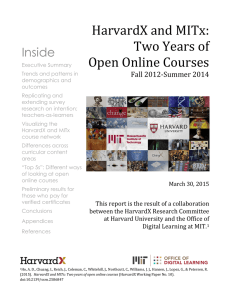MIT Institutional Research Report: Teacher
advertisement
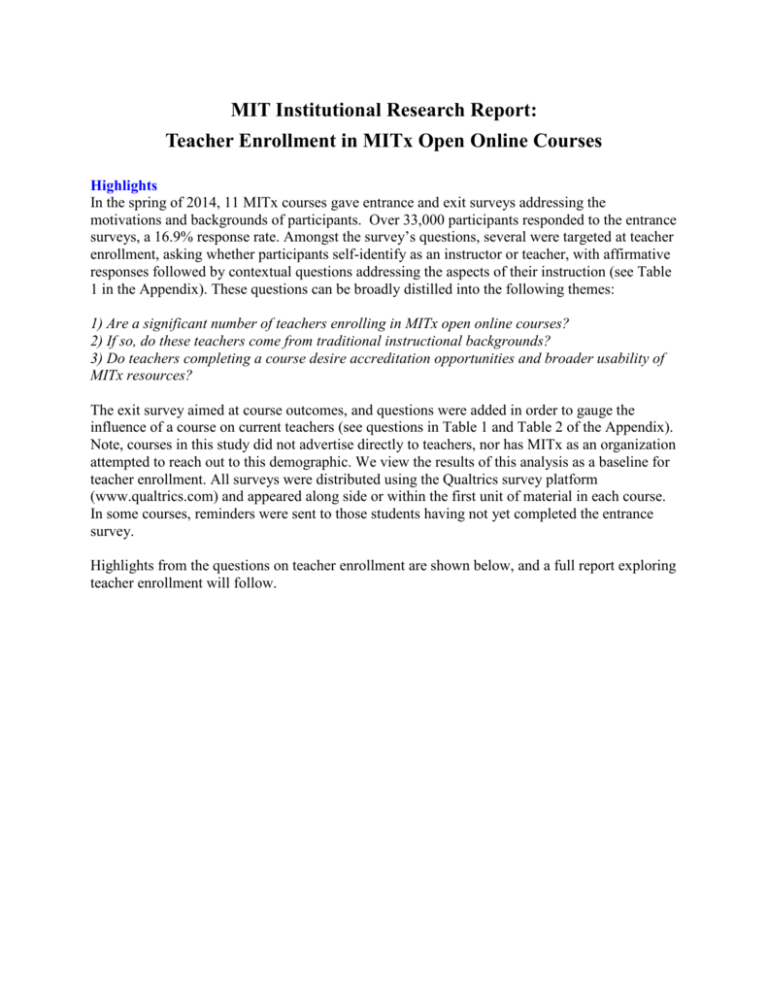
MIT Institutional Research Report: Teacher Enrollment in MITx Open Online Courses Highlights In the spring of 2014, 11 MITx courses gave entrance and exit surveys addressing the motivations and backgrounds of participants. Over 33,000 participants responded to the entrance surveys, a 16.9% response rate. Amongst the survey’s questions, several were targeted at teacher enrollment, asking whether participants self-identify as an instructor or teacher, with affirmative responses followed by contextual questions addressing the aspects of their instruction (see Table 1 in the Appendix). These questions can be broadly distilled into the following themes: 1) Are a significant number of teachers enrolling in MITx open online courses? 2) If so, do these teachers come from traditional instructional backgrounds? 3) Do teachers completing a course desire accreditation opportunities and broader usability of MITx resources? The exit survey aimed at course outcomes, and questions were added in order to gauge the influence of a course on current teachers (see questions in Table 1 and Table 2 of the Appendix). Note, courses in this study did not advertise directly to teachers, nor has MITx as an organization attempted to reach out to this demographic. We view the results of this analysis as a baseline for teacher enrollment. All surveys were distributed using the Qualtrics survey platform (www.qualtrics.com) and appeared along side or within the first unit of material in each course. In some courses, reminders were sent to those students having not yet completed the entrance survey. Highlights from the questions on teacher enrollment are shown below, and a full report exploring teacher enrollment will follow. • The 11 MITx courses capture a wide range of topics from Street-Fighting Math to Entrepreneurship 101. Launch Date Course Length Registrants by Week 3 Course Description 21W.789x Building Mobile Experiences Introduction to Probability - The Science of Uncertainty Introduction to Computational Thinking and Data Science 2014-02-04 12 Weeks 31072 2014-02-04 15 Weeks 26569 2014-03-05 9 Weeks 15065 2014-02-19 12 Weeks 13047 6.00.1x Global Warming Science Introduction to Computer Science and Programming Using Python 2014-02-19 9 Weeks 22797 15.071x The Analytics Edge 2014-03-04 11 Weeks 26530 16.110x 2014-03-05 14 Weeks 28653 15.390x Flight Vehicle Aerodynamics Entrepreneurship 101: Who is your customer? 2014-03-18 6 Weeks 44867 6.SFMx Street-Fighting Math 2014-04-08 7 Weeks 23640 3.091x_2 Solid-State Chemistry 2014-05-12 15 Weeks 6954 2.01x Elements of Structures 2014-06-03 12 Weeks 7705 6.041x 6.00.2x 12.340x • Across the 11 MITx courses, entrance surveys indicate 1 in 4 (28.0%) survey respondents identify as teachers, while nearly one in ten (8.7%) identify as current teachers. In addition, one in twenty (5.9%) identify as having taught the course topic. Course Surveyed (Question 1) Teachers (Yes to Question 1) Current Teach/Taught Topic Teachers (Yes to Question 2) (Yes to Question 4) 242 115 21W.789x 4217 933 6.041x 2400 553 197 116 6.00.2x 2997 739 216 123 12.340x 2458 956 318 277 6.00.1x 3997 956 280 143 15.071x 3010 838 183 122 16.110x 1709 441 139 86 15.390x 4843 1682 405 268 6.SFMx 4162 1364 499 333 3.091x_2 1639 506 195 144 2.01x 2058 483 173 144 Total 33490 9451 2847 1871 Average Percent 16.8% 28.0% 8.7% 5.9% • The percentages of teachers varied between courses with Global Warming Science (12.340x) attracting the most teachers and Building Mobile Experiences (21W.789x) attracting the least. • The largest percentage of teachers came from colleges and universities (post-secondary education). • Teachers were generally interested in taking what the learned from the MITx courses back to their classes. Discussion Forums An intriguing aspect of teacher enrollment involves how this group chooses to participate in courses. In addition to survey data, a tremendous amount of participant interaction data is available. Discussion forums entries and click-stream data allow one to check if participating teachers are actively pursuing an important aspect of their profession, namely, instructing other participants within a course. Discussion forums are the only source for social interaction data. These highly unstructured conversational hubs include help-seeking questions on problem solving, as well as course-wide introductions where participants state their country of origin and background. Only a fraction of participants are active posters (initiating a forum thread) and commenters (responding to posts); the majority of forum interactions simply involve searching through and reading posts (Huang 2014). Participants can post (text initiating a discussion thread), comment (responds within an existing thread), and up-vote (assign one point to a thread, where total score leads to increased visibility). In addition, one can count the total number of forum-click interactions using click-stream data. Below are the average number of posts, comments, and forum events (total clicks in the forum) for teachers (orange) versus non-teacher respondents (navy). Activity is significantly higher in 4 out of 11 courses in each category. The distributions of forum activity are highly skewed toward zero, often with a few outliers leading to significant tails toward high activity. Appendix Table 1: Entrance survey teacher questions. 1. 2. 3. 4. Question Are you currently, or have you ever identified yourself as, an instructor? If Yes, Are you, or have you, taught material related to this course? In what settings did your instruction take place? Are you currently employed as a teacher or instructor? Response Options Yes, No Yes, No, Unsure Elementary / Primary School Secondary / High School College or University Outside the scope of traditional schools Support Staff, e.g., Teaching Assistant Other (open text field) Yes, No Table 2: Cross course average percentages of current teachers’ responses to exit survey questions. Questions No Unsure Cross-Course Averages Would you be interested in teacher accreditation opportunities? e.g., Continuing education units or graduate credit. 15.1% Strongly Disagree Slightly Disagree Undecided Yes 27.3% 55.9% Slightly Agree Strongly Agree Cross-Course Averages I will use material and/or ideas from this course in my future teaching efforts. Perspective gained in this course will adjust how I teach future courses. I would be interested utilizing resources from other MITx courses in my own teaching efforts. 5% 4.3% 17% 29.7% 44% 3.8% 3.1% 17.1% 33.7% 42.3% 3.4% 3.4% 21.4% 26% 45.7% Report Prepared by: Daniel T. Seaton1*, Cody A. Coleman2, Jon P. Daries1, Isaac Chuang2-4 Affiliations: 1 Institutional Research Group, Office of the Provost, Massachusetts Institute of Technology, Cambridge, MA 02139. 2 Department of Electrical Engineering and Computer Science, Massachusetts Institute of Technology, Cambridge, MA 02139. 3 Department of Physics, Massachusetts Institute of Technology, Cambridge, MA 02139. 4 Office of Digital Learning, Massachusetts Institute of Technology, Cambridge, MA 02139. *Correspondence to: dseaton@mit.edu.
